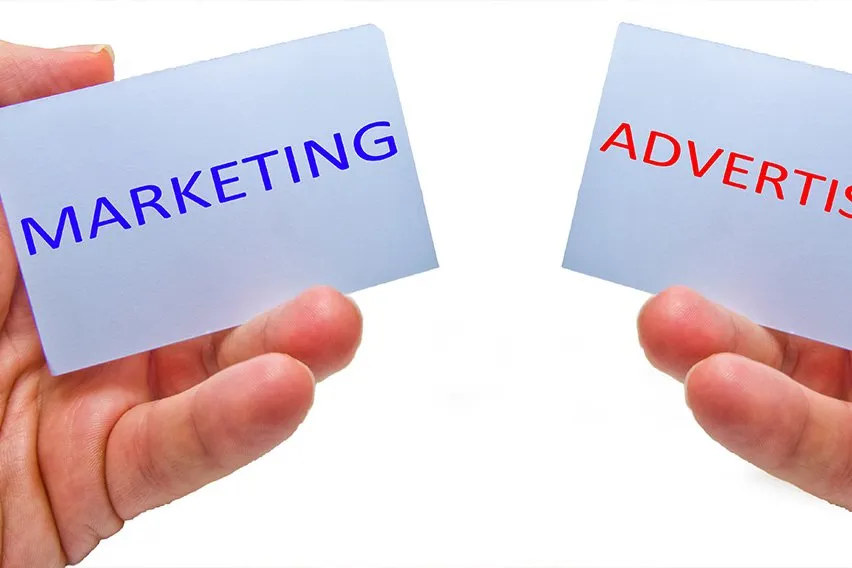The Difference Between Marketing and Advertising: Why Your Small Business Needs Both

The difference between marketing and advertising can be difficult for small businesses to grasp, since the two concepts are closely related. Advertising is actually a subset of marketing, or one component of a company’s larger marketing mix. Both marketing and advertising aim to convince customers to purchase your products and services. In large companies, marketing and advertising are often split between two departments, or marketing is handled in-house whereas an ad agency is hired to handle the company’s advertising activities. Small businesses, however, usually handle both marketing and advertising in house, so you’ll need to get a strong grasp of the two in order to effectively market and advertise your company to your target customer.
These topics explain all the subtle differences between marketing and advertising:
What’s the Difference Between Marketing and Advertising?
What’s the Difference Between Marketing and Advertising?
The difference between marketing and advertising is that marketing includes all the activities a business undertakes to facilitate an interaction between the company and a customer or prospective customer. Advertising, on the other hand, is specifically a paid public message that is persuasive and aims to gain exposure for a business’s products or services among its target customer. Here’s a deeper look at the differences between marketing and advertising:

What Is Marketing?
Marketing is the strategic planning, implementation and analysis of a company’s business activities that communicate the value of the brand to its potential and existing customers. Marketing is an umbrella term that encompasses a broad range of activities, including:
- Market research
- Product marketing
- Content marketing
- Social media promotion
- Search marketing
- Paid advertising
- Public relations
- Direct marketing
- Email marketing
- Loyalty and rewards programs
The main aim of a business’s marketing efforts is to bring customers through the sales channel, converting them from leads to paying customers with the help of specific marketing tactics. The conversion process can take a few minutes in some case, but in others, it can be an ongoing process lasting weeks or even months.
The Four P’s of Marketing
To effectively convert leads into customers, small businesses need a detailed marketing strategy to guide their work and provide measurements for success. Most marketing plans follow the four P’s of marketing:
1. Product
Product refers to the products or services a business brings to the marketplace to meet consumer demand. The business should be able to identify what current gap in the industry their product or service meets, as a unique selling point that helps solve an existing consumer problem or fills an existing need.
2. Price
Small businesses need to be strategic in the price they set for their offerings, as it plays an important role in the overall success of their marketing efforts. Different elements figure into the pricing of a product or service, including margins, value, competitor price points and more.
3. Placement
Placement refers to a company’s strategy for where customers can purchase products, whether it will be an e-commerce based product that needs to be purchased online or if it will be available at brick and mortar stores. Placement also involves product supply strategies, such as franchising, exclusive distribution or selective distribution.
4. Promotion
Promotion involves all communications tactics a business leverages to spread the message about its products and services. This includes organic communication channels and paid advertising.
What Is Advertising?
Advertising is an element of marketing that supports all other marketing activities by bringing wider exposure to the business’s products and services. Advertising identifies and communicates to a target audience with the aim of convincing the public to take a desired action, usually, to convert to a paying customer. Instead of attracting customers through organic communication, advertising uses money to cast a wider net among its target audience.
Your advertising should be creative and should communicate differently to customers at different points in the customer buying cycle. Customer purchasing behavior is broken down into six distinct stages:
- Awareness
- Knowledge
- Liking
- Preference
- Conviction
- Purchasing

Those stages can then be split into three categories, which can inform the way your advertising communicates to people at different stages:
1. Cognitive
This category relates to people at the awareness and knowledge stage of the buying cycle. They are processing the information communicated through ad messaging. Ads targeting these customers should be informative, highlighting the product benefits to grab the interest of the target audience.
2. Affective
This category covers people at the liking and preference stage of the buying cycle. At this stage, consumers are interested in relating to the brand on a more personal level. Ads targeting these people should appeal to them emotionally and make a deeper connection that way.
3. Conative
This category includes people at the conviction and purchasing stage of the buying cycle. They are committed to making a purchase. Advertising targeting these people should offer ways of speeding up the purchasing process.
Also Read: Types of Advertisement
What Is Branding?
Branding involves the visual and personal identity of a brand, including its name, logo, positioning, and online presence. Branding builds an image of your products and services in the minds of the public. It helps contribute to your public reputation. Branding is important for businesses because it builds recognition, generates new customers, and can build brand loyalty.
Branding supports a business’s advertising efforts. Your advertising strategy should directly relate to your brand and its positioning. A cohesive, persuasive advertising campaign will tie into your company branding and drive your brand goals.
RELATED ARTICLES

 How to Fill out an Invoice | Professional Invoicing Checklist
How to Fill out an Invoice | Professional Invoicing Checklist Invoice Wording: How to Word an Invoice For Your Business
Invoice Wording: How to Word an Invoice For Your Business What Does an Invoice Look Like: Everything You Need to Know
What Does an Invoice Look Like: Everything You Need to Know How to Ask for Payment Professionally: With Templates and Examples
How to Ask for Payment Professionally: With Templates and Examples 11 Construction Apps Builders Must Try In 2025
11 Construction Apps Builders Must Try In 2025 Can I Deduct Health Insurance Premiums? It Depends
Can I Deduct Health Insurance Premiums? It Depends